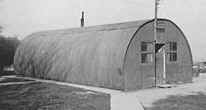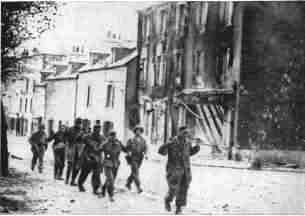In 1939 there were just two Prisoner of war camps in Britain. By the end of the war; there were more than 600.
Each camp was given a number and was either a disused building – factory, college, hotel etc, or was a specially constructed building known as a Nissen hut. A typical Nissen hut made of corrugated iron is pictured below.

Although there were German prisoners of war in Britain from 1939, Britain was reluctant to accept large numbers of German prisoners of war until there was no longer a threat of a German invasion of Britain. Prior to the successful allied defeat of Germany in Africa in 1943, the majority of German prisoners of war were sent to camps in Canada and the US.

However, after the allied invasion of Western Europe, known as D-Day, 6th June 1944, captured German soldiers were transported to Britain. Those who were Luftwaffe pilots or who were suspected of having knowledge of German military plans, were taken for interrogation before being sent to a camp. Strong Nazi supporters and members of the SS were sent to remote camps such as in the Scottish Highlands.
The terms of the Geneva Convention stipulated that prisoners of war should not be forced to work while in captivity. However, given the choice, many German prisoners of war chose to work rather than sit around the camp doing nothing. Those that chose to worked on farms – harvesting, digging ditches or repairing fences, in the construction industry – rebuilding homes damaged by bombing, or clearing bomb damage.
There were also activities within the camp such as lectures, concerts and English lessons, football and other sports. The range of alternative activities such as these varied from camp to camp.
German prisoners of war were allocated the same food ration as British servicemen and given access to medical care. However, although they were relatively well looked after many German prisoners of war suffered mentally. They had no information about their families, the state of their country or when they would be released.
At the end of the war. prisoners were subjected to a re-education program designed to equip them for life in the new Germany. Prisoners were also assessed with regard to continuing loyalty to Nazi ideals. Those that showed continuing loyalty remained in captivity. The first German prisoners of war returned to their homes in 1946, the last in 1949.
This article is part of our larger educational resource on World War Two. For a comprehensive list of World War 2 facts, including the primary actors in the war, causes, a comprehensive timeline, and bibliography, click here.
Cite This Article
"World War Two – German Prisoners of War in Britain" History on the Net© 2000-2024, Salem Media.
April 24, 2024 <https://www.historyonthenet.com/world-war-two-german-prisoners-of-war-in-britain>
More Citation Information.






